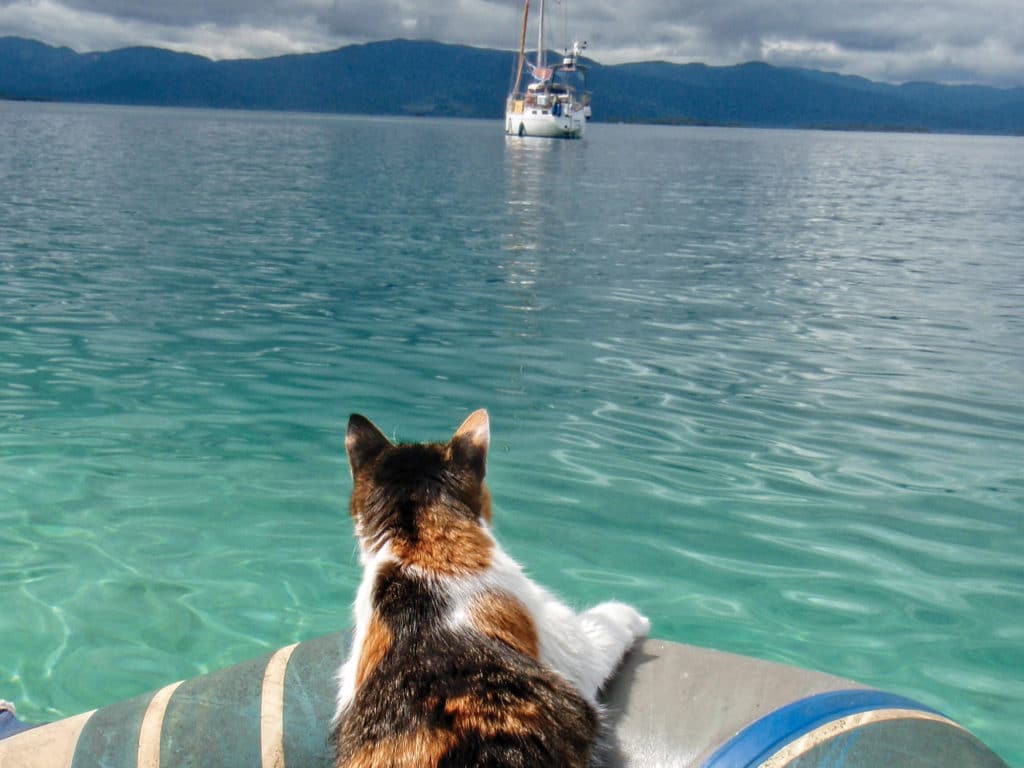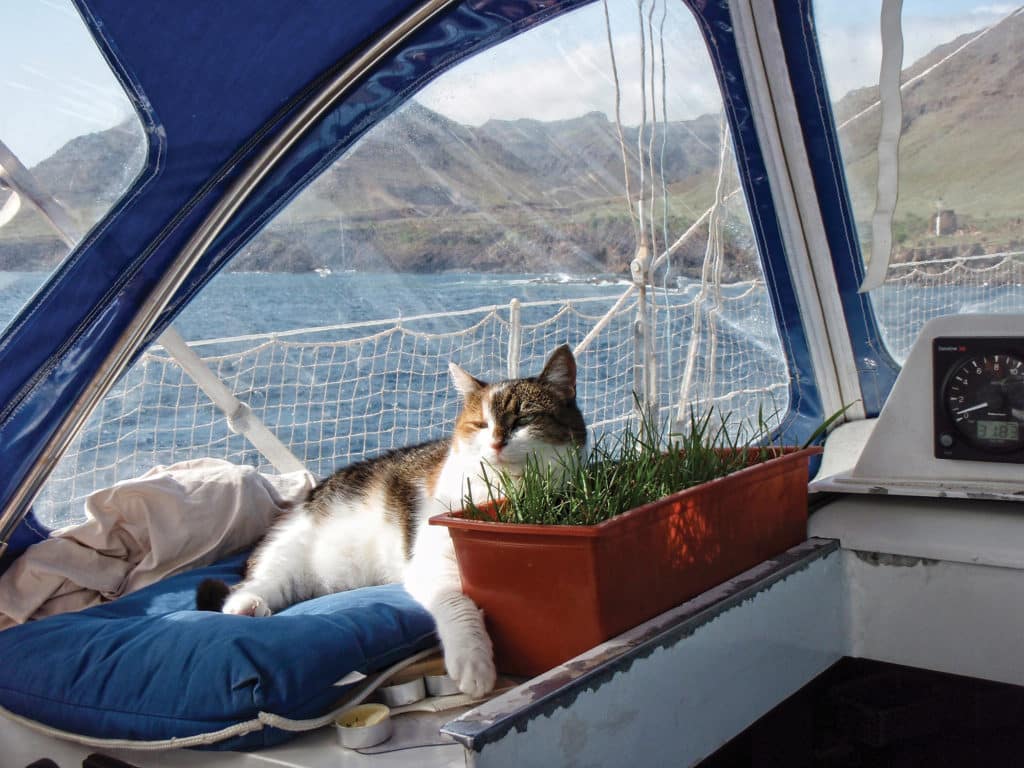
The profession of ship’s cat is as old as seafaring itself, with a long history of cats on board not just as companions, but also to help protect crew and cargo from any unwanted pests. Our cat, Leeloo, moved aboard when she was 8 years old and cruised with us for 10 years. At first, we worried about how a cat would tackle long passages, and what to expect when dealing with foreign officials, but cruising with Leeloo turned out to be easier than expected. Although she spent her first few days down below deck, Leeloo’s curiosity eventually propelled her into the cockpit, and it was (mostly) smooth sailing from there. We’ve been asked a lot of questions about having a cat on board. Each cat is different; each crew has a different vision of cruising life. There’s no one answer that works for everyone, but here are some guidelines that worked for us.
Safety On Board
When we first Googled “sailing with cats,” we got millions of hits—about catamarans. The information that actually dealt with cats on board offered some strange strategies: throwing the cat into the sea; cat swim lessons with a life vest. Along with inducing trauma, tossing a cat into the ocean could cause a pet to gulp seawater, and since elderly cats are prone to kidney problems, this is an overall bad idea. Cats instinctively know how to swim and don’t need lessons with a vest, but we recommend having a thick rope dangling into the water for a cat to use to climb back on board in the event of an emergency. We added netting around the lifelines because Pitufa’s aluminum deck didn’t provide enough grip for Leeloo’s velvet paws. We bought a harness with a leash before we set out, but Leeloo always stayed belowdecks in rough weather. In her 10 years of cruising, she never fell overboard. We tried taking her ashore in the beginning, but the excursions proved to be too stressful for her, and she hopped into the dinghy and complained loudly until we took her back to the boat. We’ve met adventurous ship’s cats that love dinghy rides and beach walks, so pack a harness and a leash just in case. Prior to overnight passages, we always packed a grab bag with essentials and stored a large dry bag next to it. We would have stuffed the cat in the dry bag if the cruiser’s worst nightmare ever came true for us.
Making the Boat Cat-Friendly
It doesn’t take a lot of effort or investment to make a boat cat-friendly. Adding a few simple things helps them settle in. We installed a cat flap into our bay-mode washboards so that when we locked the boat and went ashore, the cat could still climb up and out of the stuffy cabin. Cats love curling up in cozy hiding places (especially on passages). We kept a few cardboard boxes on board, just the right size for a cat sea berth. We added a tiny garden under the spray hood. The grass gave our cat something to nibble in the event of any fur balls in the stomach. We kept two dedicated scratch boards on deck and added a yoga mat at the base of the companionway stairs for softer landings.
Health
Veterinary clinics are easy to find in Europe, the Caribbean, and South and Central America. In the South Pacific, the situation gets trickier. There are veterinary clinics in Fiji, Tahiti and the Societies, and a small vet center with volunteers in Rarotonga, Cook Islands. There are none in Tonga. Plan on packing pharmaceuticals not just for the human crew, but also some basic medicines for the feline crew (antibiotics, painkillers). Always refer to a trained veterinarian for a diagnosis, and ask a professional whether more easily available human medication can be used on pets. Some human medicines, used in low dosages, are effective and safe for pets. But be aware that some medicines are harmful and even lethal for cats.
Some cats easily find their sea legs. Unfortunately, ours got seasick. In the beginning, she puked on passages—she learned that the sound of the anchor winch meant we were headed to sea, which was enough to send her to her cardboard box, where she would await seasick symptoms with big, round eyes. We discovered that Stugeron (or Cinnarizine, a seasickness medicine for humans) works on cats. We stocked up on a liquid form of Stugeron and gave her two drops before each passage, with another drop after eight hours of rough conditions if needed. She was fine from then on.
Cat Food and Toilet
Although we found canned goods sold in mini markets in even the most remote places, our delicate kitty munched on only high-quality brands, so we had to stock up in cities with pet stores. Fortunately, she loved fish and loudly claimed the first bites of sashimi after each catch. We kept her litter box secured on a nonskid pad below deck. We stocked up on light, silica-gel litter whenever possible and used coarse sand when we had access to beaches without bugs, changing the box every three days.
Bureaucracy
We had our cat microchipped and vaccinated with all necessary shots. We found that most countries checked only for rabies, and we always had her titer certificate, which showed her rabies test. We declared her in all ports of entry throughout the Caribbean, Central America, the Galapagos, French Polynesia, the Cook Islands, Niue and Tonga, and never had any problems. Friends who have sailed farther west in the Pacific reported similar experiences in small island nations. Officials usually checked our paperwork and pointed out that animals must remain on board. Some Pacific destinations are trickier than others: Fiji requires a bond; New Zealand requires some extensive preparations and paperwork; Australia has a long quarantine requirement for pets, with a standard 10-day quarantine for most cats and longer stays possible depending on health issues. It remains a no-go for us. Regulations can change quickly—always check before traveling to avoid unpleasant surprises.

A ship’s cat can pose some complications to the cruising life—we’ve had to skip some destinations. We were never able to leave the boat for long periods of inland travel, or leave the boat to visit family back home because we didn’t want to stress Leeloo with long-distance flights, or leave her behind. For us, it was too complicated to deal with cat sitters, but we know other cruisers who’ve had neighbors watch their pets while they were gone. For us, the positive aspects always outweighed the disadvantages: A cuddly ship’s cat adds love and joy to all daily routines. There’s a Scandinavian saying, “A house without a cat is not a home,” and we think the same goes for boats. Of course, life afloat poses some dangers to little tigers, but with a mixture of caution and trust, they can be kept safe on board.
Leeloo died in March 2021 after a decade as a ship’s cat. She never got bored on Pitufa. She never found a single rat or mouse during her long years of duty. She inspected every open locker curiously and supervised each and every one of our jobs on board. She was a happy cat, and we were lucky to enjoy her company for such a long time. —Birgit Hackl and Christian Feldbauer
To read about Leeloo and for advice on ship’s cats, read On Velvet Paws Towards the Horizon, available at pitufa.at.








